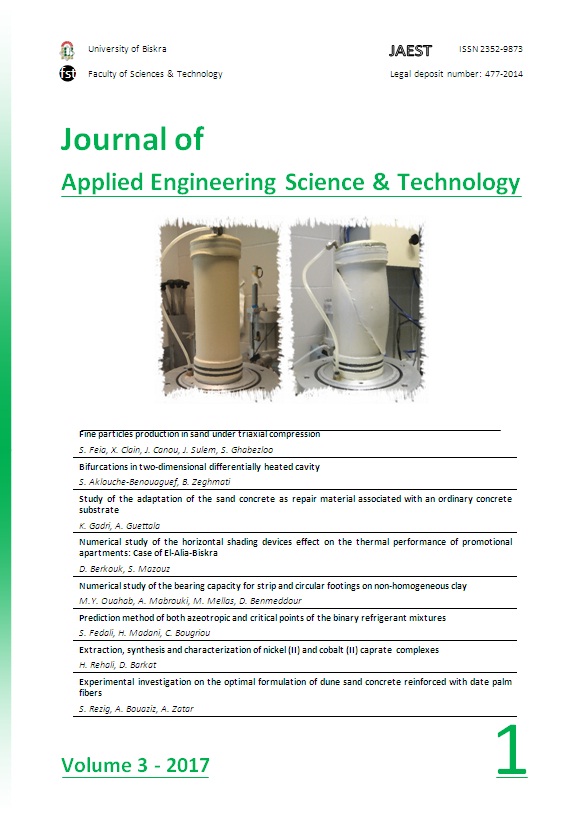DOI:
https://doi.org/10.69717/jaest.v3.i1.47Keywords:
Sand concrete, Optimal Formulation, Mechanical strength, Mass loss, Date palm fibersAbstract
The main objective of this study is to propose an optimal formulation of sand concrete.The experimental approach consists in fixing the cement dosage at 350 kg / m3 and, in the firstphase, to investigate the optimum proportions of each constituent (limestone filler, silica fume,water and adjuvant). The second phase of this study was reserved for the effect of date palm fiberson the optimal formulation deduced from the experimental program of the first phase. The datepalm fiber mass rates studied are: 0.5%, 1%, 1.5% and 2%. The results obtained from the firstphase made it possible to fix the desired optimal composition equivalent to a unit volume of sandconcrete (1 m3 ). The cement dosage was maintained at 350 kg, dune sand, alluvial sand, finelimestone, silica fume, water and superplasticizer were optimized respectively as follows: 423.98kg; 980.34 kg; 165 kg; 35 kg; 210 kg and 2%.The results obtained from the second phase showdifferent tendencies in compression than in indirect traction. Indeed, a reduction in resistance wasrecorded in compression as a function of the increase in the rate of the reinforcement of datepalm fibers. This progressive decrease can reach 27% when the rate of reinforcement is equal to2%. On the other hand, a fluctuation in the results of traction in the range of 5 to 6 MPa wasrecorded. The maximum tensile strength was reached at a date palm fiber content of 1%. Theresults obtained from the mass loss measurements clearly showed that the increase in the fiberreinforcement rate induces a decrease in the mass loss estimated at 23.5 %.
Downloads
Downloads
Published
Issue
Section
License

This work is licensed under a Creative Commons Attribution-NonCommercial 4.0 International License.
How to Cite
Most read articles by the same author(s)
- Salah Zerguine, Djamel Benmeddour, Abdallah Zatar, Numerical study of seismic earth pressures acting against a vertical retaining wall in frictional soil , Journal of Applied Engineering Science & Technology: Vol. 2 No. 1 (2016): JAEST
- Oussama Temami, Djamal Hamadi, Abdallah Zatar, Ashraf Ayoub, Experimental and numerical analyses of a thin cylindrical shell model , Journal of Applied Engineering Science & Technology: Vol. 2 No. 2 (2016): JAEST
Similar Articles
- Mohamed‐Younes Ouahab, Abdelhak Mabrouki, Mekki Mellas, Djamel Benmeddour, Numerical study of the bearing capacity for strip and circular footings on non‐ homogeneous clay , Journal of Applied Engineering Science & Technology: Vol. 3 No. 1 (2017): JAEST
- Hadj Bekki, Behavior of Soil-structure interfaces under cyclic loading for large numbers of cycles: Application to piles , Journal of Applied Engineering Science & Technology: Vol. 1 No. 1 (2014): JAEST
You may also start an advanced similarity search for this article.









